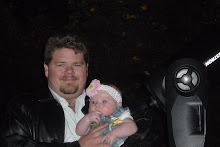
There is no easy way of saying this, so I am going to just say it... size is everything in Astronomy. Yes it's true guys, the bigger the better. The only time when when smaller is better is how it is used.
Putting the innuendoes aside, the truth of the
matter and this is the only known absolute truth with Astronomy, is that that the bigger the telescope is always better. A bigger telescope offers two advantages that can make all the difference in the world. A bigger scope means more light, this is essential because the sole p
urpose of a telescope is to collect as much light as possible and focus it to a single point on the back of your eyeball. Essentially speaking, the bigger the "objective" which is the word day, means more light. This is always true, it can never ever change. If you put my 8" schmidt next to a 30" dobsonian which is viewed on the upper left (the names aren't important at this time, just focus on the numbers), the 30" will always produce a brighter image than the 8". There is another property to be understood from this size issue: a bigger telescope will always have better resolution. If I take a 3.5" Televue refractor (Televue manufactures some of the highest grade optics for consumers and the price tag shows that at roughly $500-$1000 per inch; viewed to the lower left) and compare it side by side by a 16" Newtonian (once again don't focus on the names only the numbers) which may only cost $50 to 150$ per inch, the 16" will have better resolution. It will be able to split close double stars better than the 3.5"

So why do I have an 8" telescope and not a 30?" Well now it goes back to "smaller is better if you know how to use it" and I should also ad "how to manage it" My 8" telescope weighs in at ~70 lbs. fully assembled and it fits nicely into my Chevy Tracker with room to spare. A 30" comes in at a whopping ~200 lbs. and wouldn't fit in my car. In fact I think it is the same size as my car. There is a matter of cost as well. My 8" Schmidt cost about $2000, the 30" cost about $20,000. My scope is computerize with goto capabilities and GPS location. The 30" has none of that stock. So if I want to save my back, keep my car, and feed my family, I can feel pretty good that my 8" produces more than adequate images. So you can get a 30" monster but remember, the best scope is the one that gets used the most. If you use your $60 pair of binoculars more that your 30" out of convenience, then rest assure, you just wasted a ton of money.
Word of the Day: Objective- this is basically how big the opening is on you optical aide albeit binoculars, telescopes, and even paper towel tubes. The objective is the diameter of the front lens or mirror on your binoculars or telescope. The objective is everything and it will determine the cost of your setup and your management of the system. So consider it wisely.
Coming soon... What are those names I mentioned in this post?

